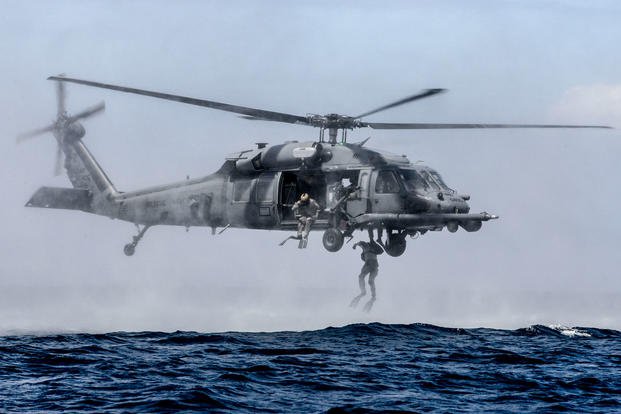KADENA AIR BASE, Japan — Airmen from the 320th Special Tactics Squadron conducted an amphibious training operation along the west coast of Okinawa Sept. 22-24 to refresh qualifications and retain proficiency in various special tactics skill sets.
The training entailed day and nighttime helo-casting in cohesion with HH-60G Pave Hawk helicopter support from the 33rd Rescue Squadron, followed by open water navigation in combat rubber raiding crafts and an open circuit navigation dive.
Through helo-casting, a special tactics team is flown to an insertion point above the water by helicopter, and members jump out of the aircraft into the water.
"It's important for us to conduct training that involves a variety of infiltration methods as it allows us to be inserted into environments that may otherwise be unreachable, which enables us to bring our skill sets to bear anywhere we're asked to," said 1st Lt. Blaze Dunn, a 320th STS special tactics officer.
The exercise participants are trained and equipped to conduct special operations tasks during high-risk combat or weather operations. Their ability to infiltrate and secure a location can lead to the recovery of personnel and equipment or enable a landing site for follow-on forces to arrive during an emergency.
"A difficult mission can come from a lot of places in an area as big as the Pacific," said Lt. Col. Edmund Loughran, the 320th STS commander. "Be it combat related or even from Mother Nature, this training allows us to respond to a crisis from either one in short order."
STS units can be comprised of combat control, pararescue, and special operations weather team Airmen. Each specialty brings a unique set of skills to the fight. Regardless of duty title, each Airman is expected to look out for one another.
"Teamwork is vital to the successful and safe completion of our missions," Dunn said. "In the high-risk and quick-moving environments our operators often find themselves, it is imperative each man on the team must trust that the man to his left, and the man to his right will tow his end of the line."
As the training concluded, team members went over the strong points that were executed with finesse and communicated improvements that can be implemented for the next operation. To make the most out of every mission, STS Airmen often sharpen their skills in order to support airpower throughout the full spectrum of missions that U.S. Special Operations Command undertakes.


























